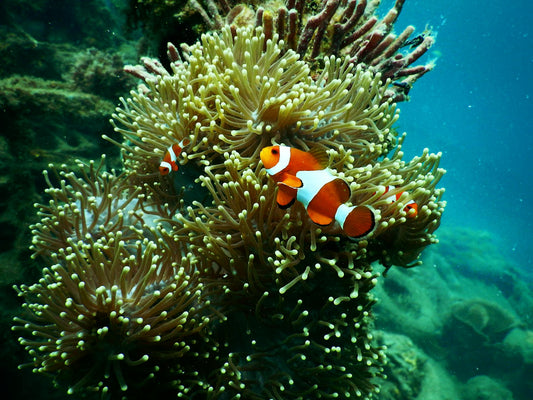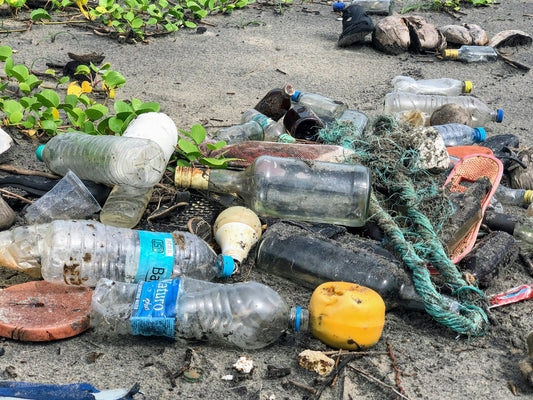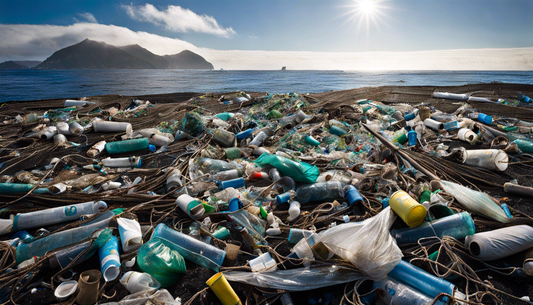Share
Picture this: You’re paddling through the Great Lakes, the sun glistening on the water… but what’s that floating by? A fish? A duck?
Nope—just another plastic bottle on its way to setting a world record in pollution.
Jump into the deep waters with me. Today we're having a swim in the Great Lakes!
Prepare yourself to be shocked a little bit about the extend of their pollution.
How Bad is the Plastic Pollution in the Great Lakes?

Beaver Bay Township Lake Superior - Credit: Andrew Ling, Unsplash
It's world record bad...
A whopping 22 million pounds of plastic are crashing the Great Lakes' pool party every year. That's like dumping the weight of 2,000 elephants into our freshwater wonderland annually. With that concentration of plastic waste, the pollution density in the Great Lakes is actually worse than in the ocean garbage patches.
But where's all this plastic coming from? Well, it's not just littering we need to point fingers at. The real culprit is our plastic-loving lifestyle and the ever-growing production of these synthetic party poopers.
But it's not just the pollution you see that's an issue. The great lakes are a huge microplastics party ground and hold a sad world record.
In 2015, researchers from the University of Toronto caught a brown bullhead catfish near Hamilton at the western tip of Lake Ontario. The team had been on a research journey, collecting 212 fish over the course of six years to investigate the effects of plastic pollution.
The team found Microplastic particles in every single one of the specimen, some of them had even migrated from the digestive system into the muscle mass of the fish.
After doing their tests, the team realized they'd just broken a sad world record.
This little brown bullhead contained 915 microplastic particles, the most ever recorded in a field study.
Finally, the Great Lakes have seen many scandals about toxic chemicals. Although the situation has improved over the past decade, many shores have posted signs that warn about consuming fish from the Great Lakes.
While there is not enough real estate on this blog to list all chemicals that were ever found in worrying concentrations, mercury, PCBs, PBDEs, and PFAS forever chemicals are part of the party crew.
Where Does All This Pollution Come From?

Man fishing mask out of lake - Credit: Thirdman, Pexels
Well, it's not like the pollution fairy magically dumps all this trash into the lakes. From careless littering to improper waste disposal, the Great Lakes have become a big dumping ground.
Let's break down where all that nasty pollution is coming from:
1. Urban Runoff
 Chicago is home to some of the big rivers flowing into the Great Lakes - Credit: Pexels
Chicago is home to some of the big rivers flowing into the Great Lakes - Credit: Pexels
Studies show that at least 80% of all plastic in lakes comes from land sources.
Much of the plastic waste we find in the Great Lakes hence comes from the cities around the shorelines,. After all, the area is home to major hubs like Chicago, Toronto, or Detroit.
Waste from those cities ends up in storm drains, which lead to small rivers, which lead to bigger rivers, which flow into the Great Lakes.
- The US National Park Service for example found that one of the greatest concentrations of microplastics in Lake Superior is found at Apostle Islands National Lakeshore, which is located near the mouth of the St. Louis River and flows through some medium size cities like Duluth on the way to the Great Lakes.
- The Chicago river is telling a similar story. Trash traps collect an average of 745 tons of garbage every year in the river, 75-95% of it being plastic waste. While those traps help catching large amounts of waste, they cannot remove everything. Whatever escapes the trash traps flows into Lake Michigan.
- A similar result was found when Toronto students set out and collected trash in and around the Don River. The river is a major inflow for Lake Ontario and flows right through Toronto on the way. The river has the highest percentage of urban area of any river in Canada. In 90 minutes, the team of students collected 1400 pieces of plastic, weighing 70 pounds in or near the Don River.
We need more representative studies to analyze sources of plastic pollution in the Great Lakes, but the examples above help us understand how cities near the shoreline contribute to pollution.
While consumer waste like plastic bottles and plastic bags are important, the role of industry in polluting the Great Lakes is sometimes overlooked.
2. Industrial Pollution

A lake contaminated with industrial pollution - Credit: yogendras31, Pixabay
The Great Lakes have a long history of industrial pollution.
For decades the Great Lakes degraded at the same pace as the industry around them thrived, and expanded.
In 1965 Maclean's magazine called Lake Erie "an odorous, slime-covered graveyard" that "may have already passed the point of no return."—Phew... what a verdict.
The other lakes weren't far behind.
The situation got so bad that in 1972 the US and Canada signed the Great Lakes Water Quality Agreement, a pact to clean up the Great Lakes.
While the Agreement helped big time, the scandals didn't stop and the results of major industrial pollution are still visible in and around the lakes.
Here is a small extract of the big corporations that used the Great Lakes as a dumping ground.
- Cuyahoga River Fires (1950s-1969): Cleveland's Cuyahoga River, which flows into Lake Erie, caught fire multiple times due to severe industrial pollution. The most famous blaze occurred in 1969, drawing national attention to water pollution issues.
- Grand Calumet River Contamination (1950s-present): The Grand Calumet River, emptying into Lake Michigan near Chicago, became heavily polluted by a variety of industries including steel mills, oil refineries, and pharmaceutical manufacturers. Contaminants included PAHs, PCBs, oil, grease, and heavy metals.
- Fox River PCB Pollution (1950s-1970s): The Fox River in Wisconsin, which flows into Green Bay on Lake Michigan, was severely contaminated with PCBs primarily from paper mills producing carbon-free copy paper.
-
White Lake, Michigan Contamination (1950s-1980s): This lake near Lake Michigan was deeply polluted by years of dumping from a tannery and chemical company.
- Presque Isle Bay Pollution (1950s-1990s): Located on the southern shore of Lake Erie, this bay was contaminated with PAHs and heavy metals from steel mills, a foundry, and other industrial activities.
- Mirex Pollution (1973): in 1973 scientists found that the Hooker Chemical Company was dumping mirex into Lake Ontario from its plant in Niagara Falls (NY), a highly toxic pesticide. The incident shut down fishing in the lake and the results are still visible today. As you take a walk around Lake Ontario, you can still see signs showing levels of chemical pollution in fish such as coho salmon and lake trout and recommended consumption limits of those fish.
- East Palestine Train Derailment (2023): While not directly in the Great Lakes, this incident led to the spread of toxic chemicals, including vinyl chloride and butyl acrylate, to 16 states. The study suggests that all Great Lakes except Lake Superior were likely affected.
- Toronto Oil Spill (2023): A massive fire at a chemical distribution facility in northwest Toronto led to contaminated runoff flowing into Mimico and Humber creeks, eventually reaching Lake Ontario. The spill, containing oil mixed with firefighting foam, traveled 12 kilometers downstream, impacting wildlife and water quality.
An honourable mention that unfortunately has not gained as much public attention yet is the hundreds of thousands of small plastic pellets that spill into the great lakes from plastic industry facilities in the vicinity.
Researchers estimate that 13% of plastic waste in the great lakes comes from pre-production pellets used by the plastic industry.
3. Littering

Litter collected at Lake Ontario in a perimeter of 30ft (10m) - Credit: SWOP
While industrial pollution and run-off are major categories of pollution in the Great Lakes, littering on the shorelines also plays a big role as well.
A recent report from the Alliance for the Great Lakes shares findings from 20 years of beach cleanups around all great lakes.
Microplastics now represent the biggest category of litter, but they are followed by classic litter items like cigarette butts, bottles and bottle caps, food wrappers, straws and stirrers.
The report states that 49% of trash found is food or smoking related and stems from littering at the shoreline.
4. Others
Finally, there are many smaller contributors to the pollution we find in the Great Lakes. those include things like
- Oil residue and fishing gear left from fishing and boating activities
- Agricultural runoff that travels into the Great Lakes from fields and farms in the vicinity through rivers and underground waterways
- Commercial shipping that uses the Great Lakes as major transport routes and can spill goods and fuel
- Probably many more...
Why Should we Care?
Now you may ask yourself: Pollution is never nice, but why should I care so much about pollution in the Great Lakes?
Well, these big lakes aren't just beautiful. There are a few really good reasons to keep the Great Lakes healthy.
They are Earth’s biggest fresh water source. They span a whopping 94,000 square miles and hold an almost ridiculous six quadrillion gallons of water. That’s one-fifth of the world’s fresh surface water and about 90% of the U.S. reserve—so yeah, kind of a big deal.
And while they look pretty on postcards; they also keep over 40 million people in the U.S. and Canada hydrated.
They also fuel over 1.5 million jobs and pay $60 billion in wages every year. And let’s not forget the 3,500+ plant and animal species living here—some of which you won’t find anywhere else.
If the Great Lakes region were its own country, its $6 trillion economy would rank among the biggest in the world. Not bad for a place known for epic fishing trips, boating adventures, and the occasional lake monster conspiracy.
Recreation alone brings in over $52 billion a year, proving that people will pay good money for a pristine lake vacation.
Long story short: Think of the Great Lakes as the reliable friend who always shows up—rain or shine. But even they need some TLC.
Because let’s be honest, nobody wants to vacation at “The Okay Lakes.”
How Can We Help?

A lighthouse at Lake Erie, Ohio - Credit: Miketoler820, Pixabay
Protecting the Great Lakes starts with small, everyday actions that add up to a big impact. Here are some practical ways you can make a difference:
- Reduce Plastic Use – Choose sustainable alternatives over single-use plastics. Opt for refillable water bottles, bring your own shopping bags, and say no to plastic straws and cutlery.
-
Dispose of Waste Responsibly – Recycle properly, compost when possible, and ensure trash doesn’t end up in nature.
- Support Policy & Legislation – Advocate for stronger regulations on plastic pollution. Contact your representatives, support bans on harmful plastics, and stay informed on environmental policies.
- Be Mindful of Personal Care Products – Avoid items containing microplastics, like certain exfoliating scrubs and toothpaste. Look for eco-friendly alternatives with natural ingredients.
- Make Sustainable Shopping Choices – Support businesses that prioritize plastic-free packaging and sustainable materials. Choose products with minimal or biodegradable packaging.
- Educate & Inspire Others – Share information about pollution and the importance of protecting the Great Lakes with your friends, family, and community. Awareness leads to action!
-
Support Organizations Protecting the Great Lakes – Donate to or volunteer with groups working to preserve these vital ecosystems. Organizations like the Alliance for the Great Lakes, Freshwater Future, and Great Lakes Protection Fund play a crucial role in conservation efforts.
Every choice matters. The more we commit to these habits, the healthier our lakes—and our planet—will be.
The Great Lakes (and all the cute critters in them) will thank you for it.
We hope you enjoyed this article. Please feel free to leave a comment below if you want to engage in the discussion.
If you want to read more like this, make sure to check out our Blog and follow us on Instagram. If you are interested in truly sustainable products, check out our Shop.

![Plastic Pollution in the Great Lakes [2025]](http://www.shop-without-plastic.com/cdn/shop/articles/andrew-ling-hxmFA94vrJ4-unsplash.jpg?v=1738325988&width=1500)






